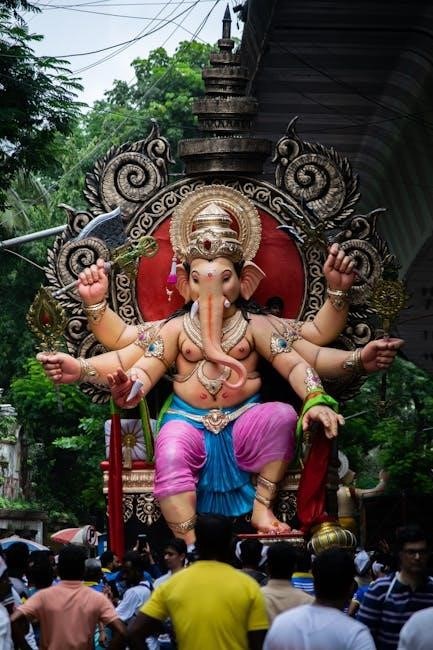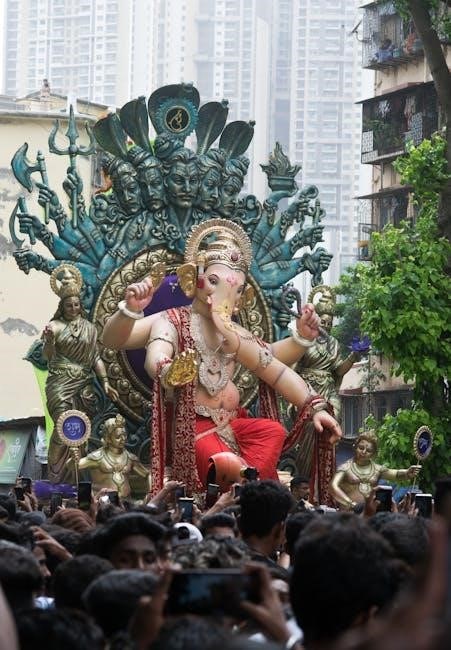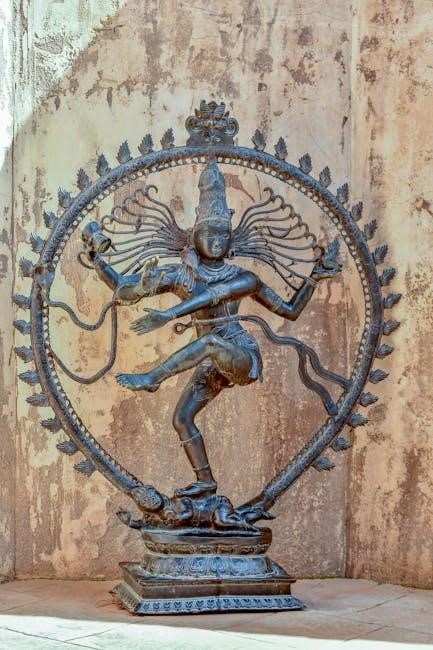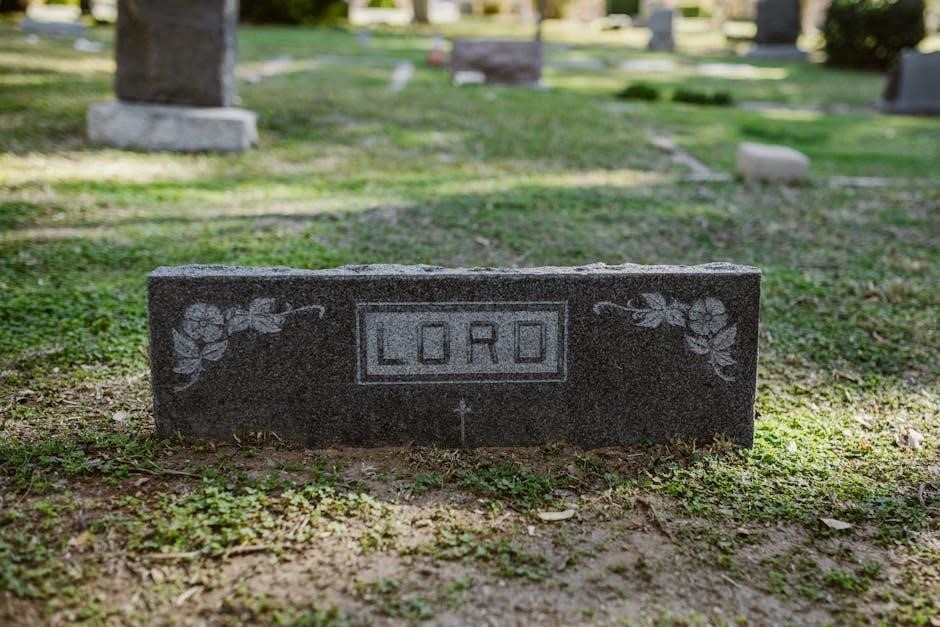William Golding’s 1954 novel explores human nature through boys stranded on an island, revealing themes of civilization, savagery, and society without adult supervision, sparking moral reflection.
Overview of the Novel
Lord of the Flies, written by William Golding, is a thought-provoking novel that explores the behavior of young boys stranded on a remote island after a plane crash. With no adult supervision, the boys initially attempt to create a utopian society but gradually descend into chaos and savagery. The story follows Ralph, the elected leader, and his clash with Jack, who becomes increasingly consumed by the thrill of hunting. As the novel progresses, the boys’ primal instincts surface, leading to power struggles, fear of a mysterious “beast,” and ultimately, tragic consequences. Published in 1954, the book serves as a gripping allegory of human nature, societal collapse, and the effects of isolation. Its vivid portrayal of innocence lost has made it a timeless classic in world literature.
Historical Context and Themes
Lord of the Flies, written by William Golding in 1954, is deeply rooted in the post-World War II era, reflecting widespread disillusionment with the idea of inherent human goodness. The novel explores themes of human nature, civilization versus savagery, and the effects of fear and power dynamics. Set during an unspecified war, the story of boys stranded on an island serves as an allegory for societal collapse. Golding critiques the idea of progress and order, suggesting that humanity’s primal instincts lie just beneath the surface of civilization. The novel’s dark themes resonated with the Cold War era’s existential anxieties, making it a powerful commentary on human behavior and the fragility of moral structures. Its timeless relevance continues to spark reflection on humanity’s capacity for both good and evil.

Key Themes in “Lord of the Flies”
The novel explores the nature of humanity, revealing how quickly civilization collapses when primal instincts dominate, highlighting themes of fear, power, and moral decay.
The Nature of Humanity
Golding examines humanity through the boys’ behavior, showing their descent from order to chaos. The conch shell, symbolizing democracy, loses power as fear and savagery dominate, revealing primal instincts.
Civilization vs. Savagery
The novel explores the tension between civilization and savagery through the boys’ behavior. Initially, they attempt to create order with rules and the conch shell, symbolizing democracy and civility. However, as fear of the “beast” grows, primal instincts take over, leading to chaos and violence. Ralph, representing reason and leadership, struggles to maintain control, while Jack’s desire for power and hunting embodies the descent into savagery. The conch shell, once a symbol of unity, loses its power as the boys abandon moral constraints. This conflict reflects Golding’s view that humanity’s innate savagery is suppressed by civilization but easily unleashed in the absence of societal structures.

Major Characters and Their Roles
Ralph, the protagonist, embodies leadership and civilization, while Jack represents the descent into savagery. Piggy, the intelligent voice of reason, symbolizes wisdom and morality, contrasting the group’s primal instincts.
Ralph and His Leadership
Ralph, the protagonist, emerges as a natural leader, advocating for shelter-building and maintaining order. His desire to create a list of names and hold meetings reflects his organizational mindset. Ralph’s leadership emphasizes survival and civility, often clashing with Jack’s primal instincts. The conch shell becomes a symbol of his democratic approach, allowing everyone to speak. Ralph’s commitment to rules and fairness highlights his belief in maintaining societal norms. His leadership is tested as the group faces challenges, revealing both his strengths and vulnerabilities. Through Ralph, Golding explores the tension between order and chaos, illustrating how leadership can shape the behavior of individuals in isolation.
Jack and His Descent into Savagery
Jack Merridew’s transformation from a choirboy to a savage leader underscores the novel’s exploration of human nature. Initially, Jack supports Ralph’s leadership but gradually prioritizes hunting and power. His obsession with killing pigs symbolizes his descent into primal instincts. Jack’s desire for control leads him to form his own tribe, embracing savagery and rejecting civilization. The painted masks and chants signify his complete surrender to barbarism. His actions highlight the ease with which civility can erode, revealing the darker aspects of humanity. Jack’s character serves as a foil to Ralph, emphasizing the conflict between order and chaos, and the dangers of unchecked ambition.

Symbols in the Novel
The novel uses symbols like the conch shell, representing order, and the beast, embodying fear, to explore human nature, society, and the descent into savagery on the island.
The Conch Shell and Its Significance
The conch shell is a powerful symbol in Lord of the Flies, representing order, democracy, and civilization. Found by Piggy, it is used by Ralph to call meetings and maintain structure among the boys. Whoever holds the shell has the right to speak, emphasizing equality and fairness; As the novel progresses, the shell’s influence wanes, symbolizing the erosion of civility and the rise of chaos. Its destruction later in the story marks the complete collapse of the boys’ attempts at governance, highlighting the descent into savagery. The conch shell serves as a poignant reminder of the fragile nature of societal norms and the ease with which they can be abandoned.
The Beast as a Symbol of Fear
The Beast in Lord of the Flies symbolizes the primal fears embedded in human consciousness. Initially, the boys believe it is a physical monster, but it evolves into a representation of their inner anxieties and the unknown. The Beast sparks paranoia, dividing the group and undermining their attempts at civility. Piggy rationalizes it as a product of their imaginations, while Jack uses it to manipulate fear and gain power. The Beast becomes a unifying force of terror, driving the boys to abandon reason and descend into savagery. Ultimately, it embodies the darker aspects of human nature, revealing how fear can dismantle order and lead to chaos. The Beast’s presence haunts the novel, underscoring the fragility of human control over primal instincts.

Moral Lessons and Teachings
Lord of the Flies teaches the importance of order, rules, and morality in society. It highlights the dangers of unchecked ambition, greed, and the descent into savagery, emphasizing human nature’s duality between good and evil.
The Importance of Order and Rules
In Lord of the Flies, the conch shell symbolizes democracy and order, as it grants the right to speak during gatherings. Initially, rules maintain civility, but their gradual disregard leads to chaos. Ralph’s emphasis on building shelters and maintaining a signal fire reflects his belief in structured society. However, as the boys’ behavior becomes more primal, rules are ignored, and fear replaces reason. The novel illustrates how without enforced rules, human behavior deteriorates, leading to savagery. The collapse of order mirrors the boys’ loss of innocence, emphasizing the necessity of rules to uphold civilization and protect individuals from their darker impulses.
The Dangers of Unchecked Ambition
Jack Merridew’s relentless pursuit of power and control exemplifies the dangers of unchecked ambition in Lord of the Flies. Initially, Jack’s desire to hunt and provide for the group seems noble, but it quickly escalates into an obsession with dominance. His ambition to lead and exert authority over others drives him to abandon moral constraints, leading to chaos and violence. Jack manipulates fear and superstition to gain followers, illustrating how unchecked ambition corrupts even the most well-intentioned individuals. The novel warns that when ambition is prioritized over collective well-being, it fosters division and destruction, ultimately undermining the stability of the group and revealing the darker aspects of human nature.
William Golding’s Lord of the Flies delivers a profound exploration of humanity, revealing the fragile balance between civilization and savagery. Through the boys’ descent into chaos, Golding illustrates how fear, ambition, and the absence of moral authority can undermine societal norms. The novel underscores the importance of order, empathy, and ethical leadership in preserving humanity. Ultimately, the story serves as a cautionary tale about the dangers of unchecked desires and the erosion of moral boundaries. Its timeless themes resonate universally, inviting readers to reflect on the darker aspects of human nature and the necessity of maintaining civility in the face of adversity. Golding’s masterpiece remains a vital commentary on the human condition.
